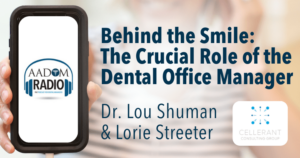Fostering Strong Relationships Between Office Managers and Hygienists

Similar to politics, dental team members often split along “party” lines – the business team and the clinical one.
Yet, in order to become a highly productive and efficient practice, team members need to support and encourage each other across the board. This is especially true of the relationships between office managers and hygienists.
When each party respects, trusts, and educates each other about their role within the practice, the sky is the limit for patient case acceptance and care.
Relationships between office managers and hygienists
Hygienists, by nature, are educators – educating patients and others about oral health. Office managers are often detail-oriented and task-driven. The two can often be at odds with each other’s goals due to where they’re coming from. When a discussion as to what’s important to each is pursued, a better understanding and appreciation of their role within the practice can be achieved.
The office manager and the hygienist each have to be the leader of their role and explain to the other their responsibilities within the practice. As a leader, each has to have good communication skills while being open to discussion, a clear sense of purpose as to what needs to be accomplished, and the willingness to pursue what needs to be achieved.
If one lacks a true understanding of the other’s goals and purpose, conflict is sure to arise.
How to resolve conflict in the dental office
Conflict is not necessarily bad, but it can affect the practice’s productivity and profitability, especially when it occurs between the front office and the clinical team. Patients can sense conflict, which can cause a decline in treatment or a false acceptance rate of it. False acceptance occurs when a patient says “yes,” but on the day before or of the treatment, cancels or no-shows without a reasonable explanation.
Any discussion between the hygienist and dental office manager about each other’s roles needs to occur when time is available. Each person should be open to the discussion and extensive use of the “I” type of message delivery.
“I” messages involve the:
- Use of a sincere emotion that is encountered
- Behavior or conflict issue
- Negative effect the conflict is having on the practice, individual or patients
An example of an “I” message would be, “I am frustrated when clinical notes are inaccurate since I can’t document the reason for treatment to the insurance company, causing a delay in the patient’s care.” In this example, frustration is the emotion, the inaccurate clinical notes are the behavior, and the negative effect is the delay of patient care.
When the “I” message is used, team members are more open to hearing the discussion rather than shutting down when “You” is used. “You” points the finger of blame at specific individuals, whether rightly or wrongly, causing them to be defensive. When blame is assigned, nothing is accomplished.
“I” allows the conversation to continue so that solutions can be brainstormed and addressed. “I” messages build trust and respect.
On the opposite side, how many times does the hygienist complain that there is not enough time allowed for patient care? Yes, dentistry can be time-crunched in today’s environment, but educating patients, performing periodontal charting, and completing a thorough cleaning are all important components of the hygienist’s responsibility.
Patients must have an understanding of their condition. Patients are savvier than ever about their health, and providing time to educate them about various oral needs can reap dividends for the practice.
How to help your dental hygiene team
Has your practice done a recent procedure analysis for the hygiene team? A procedure analysis reviews the time required for various procedures and determines the best course of action for that procedure to be offered.
The hygiene procedure analysis begins as a timing from the moment the hygienist takes the patient from the reception area, through the various aspects of hygiene care, to hand-off with the business team and finally the turnover of the operatory for the next patient.
This analysis is done over the course of a variety of hygiene procedures and days, with the averages used to determine appropriate time requirements for scheduling. Doing a procedure analysis can be eye-opening to both the hygienist and the office manager.
Defining accountability in the dental office
Training is essential for any team member, whether a long-time employee or a new hire. Practices often assume that the hygienist understands various practice or technology-specific protocols, so no training is ever offered. This may be true, but an office manager should communicate with the hygienist regarding the specifics of her/his position within the practice or practice-specific protocols.
If someone doesn’t fully understand their role and responsibilities, how can they be held accountable?
As an office manager who reports to the owner/dentist, your own role and responsibilities are clearly defined. Otherwise, you can’t be held accountable. It’s no different for a hygienist or any other team member.
As the office manager, it’s your responsibility to hold team members accountable, both positively and negatively; but if clearly defined roles and training are not offered and communicated, this accountability cannot happen.
Help foster strong relationships between office managers and hygienists
Strong relationships between dental office managers and hygienists are built on open lines of communication and honesty. Providing team members with proper training is part of the trust-communication commitment. Education, communication, and trust help build strong relationships between you and the hygienist. Commit to the correct dialogue with your hygiene team to achieve more for your patients and practice over time!
Meet the Author

Ann-Marie DePalma, CDA, RDH, MEd, FADIA, FAADH is a graduate of the Forsyth School for Dental Hygienists, Northeastern University and the University of Massachusetts Boston. Ann-Marie is a Fellow and Certified Educator of the Association of Dental Implant Auxiliaries (ADIA), a Fellow of the American Academy of Dental Hygiene (AADH), a continuous member of American Dental Hygienists’ Association (ADHA), as well as a member of American Association of Dental Office Managers (AADOM). She is the 2017 Esther Wilkins Distinguished Alumni of Forsyth Award recipient.
Ann-Marie spent 25+ years in clinical hygiene, has experience in dental hygiene and assisting education and as a business/clinical consultant. She is currently employed as a technology advisor/trainer. In addition, Ann-Marie is a published author with dental hygiene publications and textbooks and provides continuing education programs for dental teams.
To contact Ann-Marie, email her at amrdh@aol.com.







